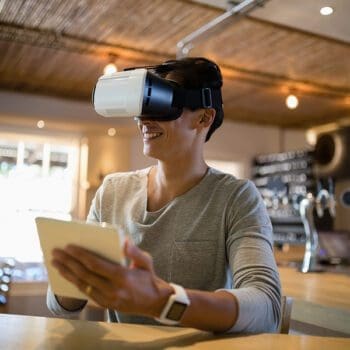 Hotel marketing can be a challenge at times, thanks to the sheer volume of competitors you’re constantly up against. Being able to keep your finger on the pulse of new trends and innovations can make a big difference when it comes to the success of your marketing campaigns.
Hotel marketing can be a challenge at times, thanks to the sheer volume of competitors you’re constantly up against. Being able to keep your finger on the pulse of new trends and innovations can make a big difference when it comes to the success of your marketing campaigns.
In today’s tech-forward world, that includes exploring immersive virtual experiences to give guests a full sense of the unique highlights and character of your space. That isn’t always possible with still photography or short video formats.
Virtual reality is nothing new, but it’s still a relatively untapped territory in the world of hotel marketing. You can jump on it now, stand out from your competitors, and entice your guests to book a room with you by giving them a glimpse of what they can expect during their stay.
Let’s dig a little deeper into video and 3D experiences, and how you can use them in your marketing strategy to bring your hotel space to life online.
Utilize the metaverse
The metaverse is still relatively new for most people, but it could potentially change the entire travel industry. It combines virtual reality and augmented reality to create an interactive virtual world for people to explore. It’s not just a visual experience. Rather, it allows people to participate using avatars. They can spend time with family and friends, talk to each other, and experience locations across the globe without leaving home.
That might not initially sound great for the hospitality industry, but it goes further than just “virtual vacations.” You can leverage the metaverse in your hotel marketing in a variety of ways if you’re willing to get creative. Consider implementing it by:
- Creating loyalty programs with activities and challenges in the metaverse
- Holding events and meetings
- Upselling rooms and amenities
- Showing off the hotel’s restaurant menu
Virtual tourism has its place and will undoubtedly become more popular as technology continues to advance. However, it might serve as a springboard for in-person travel if you utilize the metaverse to your advantage by giving potential guests a taste of what they can look forward to when they book with you.
Long-form videos
Video marketing has continued to grow in popularity over the last several years, and it’s still one of the top ways to attract attention and engage with your target market. Nowadays, short-form video is everywhere, and it certainly has its place. You can utilize it on social media platforms like TikTok and Instagram to intrigue potential guests and encourage them to follow your brand — especially if you have a younger demographic.
However, if you want to create a more immersive experience, invest some time into creating long-form videos.
By showcasing longer videos, you can make your audience feel like they’re already a part of your hotel before they even step foot inside. Focus on things like behind-the-scenes footage, food and beverage options, amenities and services, and even local attractions. It’s also a good idea to give tours of your rooms.
Video goes much further than photographs ever will, and with some light narration and attention to detail, people will end up being able to visualize themselves in each room. This is a great way to garner interest and keep people coming back for more. If you have a YouTube channel, consistently creating new videos can help attract new subscribers and get viewers excited about your content.
Stepping into virtual reality
It’s easy to think about virtual reality and automatically associate it with video games or entertainment. But, it’s come a long way in recent years, and can be a great marketing tool when used the right way.
VR options can be used in many of the same ways as long-form video. The big difference? It’s more immersive. Instead of just watching a video, a potential guest can look at your content through the scope of VR and potentially feel like they’re walking around one of your rooms, or strolling through your lobby.
Beyond that, VR can give people considering your hotel the opportunity to determine if it’s the right fit for them. Maybe they want to see the view from a particular room to see if it’s really within walking distance of the beach. Maybe they want to scope out nearby restaurants, or see if the lobby or in-house restaurant is friendly for kids. It’s a much easier option than bringing a family of four to a hotel and realizing it doesn’t fit their personal needs.
In the hospitality industry, VR still has some growing to do. If you offer virtual reality experiences, you’re assuming your potential guests have the technology at home to view them (VR headsets or monitors). More people will start to acquire these different tech tools as things advance and as VR becomes more prominent for more than just gaming and entertainment. If you choose to use it in your industry, you’ll be a bit of a trailblazer, but it will also help you stand out until other hotels start to notice the effectiveness of such an immersive experience.
There’s no denying the impact technology has had — and will continue to have — on the hospitality industry. Don’t hesitate to take advantage of it in your hotel marketing now, so you can give your guests immersive, unique experiences that will encourage them to book with you more frequently.




















